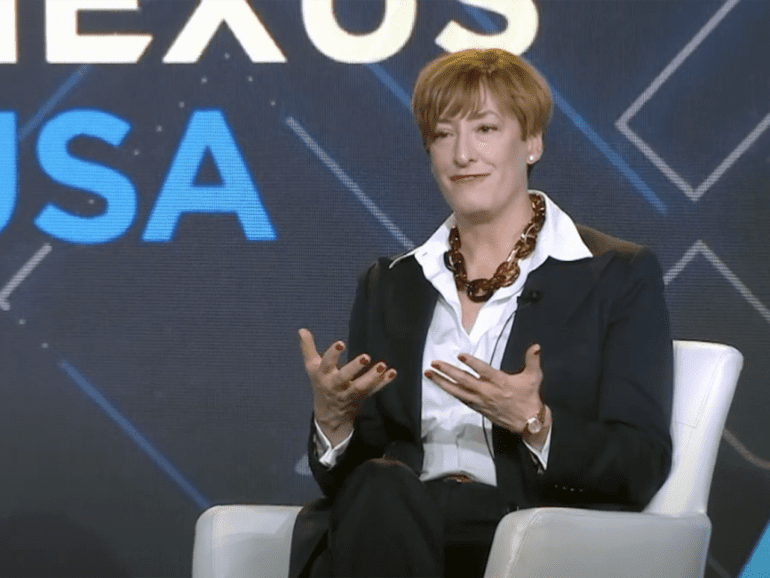While they may nominally be competitors in the space, Cross River Bank’s Gilles Gade and Caitlin Long from Custodia Bank share many of the same thoughts on what needs to occur for the future of finance and digital assets to unfold properly, such as proper action from regulators.
Gade and Long appeared at Fintech Nexus 2022 in New York City. Stumbling Blocks to Stepping Stones: Building the Future of Finance From Vision to Reality was moderated by Axios’ Lucinda Shen.

The industry needs proper protections for innovation and growth to fulfill its potential. Banking infrastructure is the appropriate regulatory infrastructure for stablecoin issuance and custody functions.
“We vehemently agreed on the concept of open banking and API-based banking and exposing APIs to your customers so they can write software and make their lives easier,” Long said. “And it’s amazing how few banks actually do that.”
Control of the future of fintech is undecided
Gade believes the future is still up for grabs and that no one existing company will rule the space. That is good because the little companies are risking and engaging regulators to sort out an opaque regulatory environment.
“I don’t think a big bank can take that risk today,” Gade said.

Custodia Bank does not want to lend. Long said Custodia’s model focuses on building networks of networks. That counters the traditional spending model on customer acquisition and expanding profitability through cross-selling. Custodia will drive revenue through fee generation.
What is not well-known about Cross River is that its underlying technology allows fintech partners to focus on growth, Gade said. That fintech can also access Cross River’s core processor, which conducts real-time transactions. The payment infrastructure allows payments firms to initiate lending and lenders to do the reverse.
“True (that) today there is a preeminence of revenue on the lending side,” Gade said. “However, the payment side and the BaaS side and the infrastructure play is rapidly catching up.
“Ultimately, it’s that core infrastructure that enables all these players to evolve. And wherever the revenue falls this year or next year as a percentage between lending and payment is to us irrelevant. It’s all fintech.”
Regulatory headaches remain an obstacle
Regulation is a significant stumbling block for Custodia, Long said. Custodia is a Wyoming-chartered special-purpose depository institution that has applied for a Fed master account to become a federal bank. What was initially said to take a maximum of seven business days to complete has reached 19 months.
Some good news is that the Fed recently designated Custodia as a depository institution. Trust companies and money transmitters are not legally depository institutions, so this is significant, Long explained.
“To be eligible to have an account at the Fed, you need to be a depository institution,” she said. “The Federal Reserve Act says that you’re eligible for a Fed master account if you’re an insured depository institution or a depository institution eligible to apply for insurance. We’re in the latter category.
“So once they determine we were a depository institution, it’s now a question of when not if because the Federal Reserve Act actually is obvious, it says the Fed shall make the following list of services available to all depository institutions on a non-discriminatory basis.”
What should be the necessary approvals and paperwork, and what is causing the delay? Long knows one factor is that regulators are struggling with cryptocurrencies. Once they develop competency, staff get picked off by the private sector and lured by higher pay and green fields.

The ultimate victors will need persistence
There is an opportunity here; it largely depends on your viewpoint, Gade said. Custodia has faced stumbling blocks such as delays and uncertainty of which regulator will oversee them.
“Custodia’s pushing through (and) turning this into an opportunity,” Gade said. “That means blazing the trail because if that gets solved, imagine what that’s going to do for the rest of the country.
“This is critical to really understand that there isn’t such a thing as a stumbling block in terms of the regulatory side. Ultimately, things will follow through for those who dare challenge the status quo.”
DeFi has its issues
The leaderless nature of DeFi and DAOs complicates matters from a regulatory perspective, Long said. The lack of clearly defined leadership makes passing KYC requirements impossible. Smart DeFi organizations are naming control people who have governance responsibilities as a response.
“Once you have a control person who actually has some governance responsibilities in the organization, and they can be voted on through the DAO structure to do that, then they can actually get a bank account,” Long said. “There are DAOs with bank accounts, but certainly, it’s not the norm. It’s a function of the structure and whether they can pass KYC.”
Does defined leadership allow such structures to remain as DeFi and DAOs by definition?
“No,” Long said. “They’re hybrids.”
Significant market opportunity remains
Given the number of BaaS and embedded financial services companies, how ample is the market opportunity for new entrants?
More than being an industry, banking today is a commodity and a functionality, Gade explained. After 2008 the big banks de-risked, opening the door for the Prospers and Lending Clubs to fill a tremendous void.
That should not be a surprise, Gade said. The original industry had been around for 200 years and operated in one way. Then they shut out a significant percentage of the populace and let the innovators in.
It may be too late for the old guard to turn back the clock, too, Gade suggested.
“I truly believe it’s a little bit too late for the banks to wake up and pivot to cater to an industry that has already moved on. The consumer loves to shop on Affirm, Shopify, Amazon…take a loan right there, and open an account of crypto rewards. It’s an experience, totally different.”
The two biggest needs
The priority then becomes ensuring these new companies have the proper infrastructure to meet the needs and wants of the marketplace, Gage added. Confirm that and provide consumer protections are also in place. Solve it, and everything falls into place.
The market in 2042
What does the market look like 20 years from now? For Gade, it’s about being in the right place at the right time. Read the environment and adjust your plans accordingly. Cross River lets the market play out while listening to clients, consumers, and regulators.
Long believes many of the USD on- and off-ramps for digital assets will be banks. The money transmission and trust company structure doesn’t work. Better systems are coming, but it’s a long and painful process. Had authorities acted faster on Custodia’s application, perhaps many would not have been victimized in a Ponzi scheme.
Long predicted that there will also be real-time gross settlement payment infrastructure within the next five years. That will be an issue for community banks that don’t have API-based systems that can handle transactions at that speed.
“There’s no reason why the debit and credit can’t be settled simultaneously,” Long said. “And right now it’s not, and the delays, the operational risks, the counterparty risks, the cost, working capital that entails, all of those costs are going to be abstracted away because technology will solve it.”


